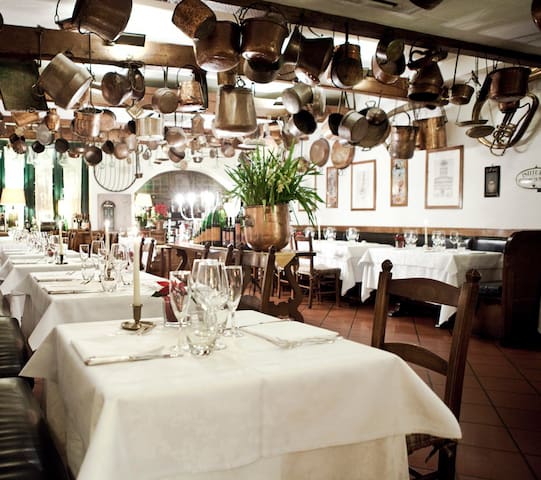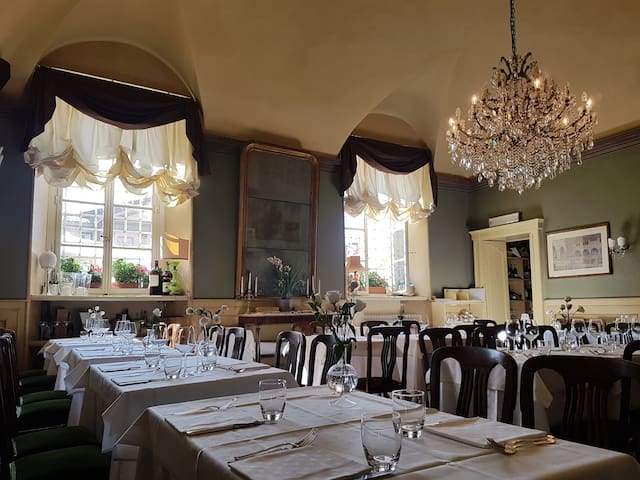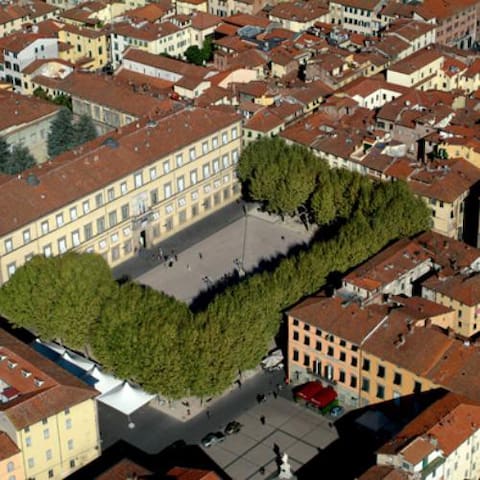Offerta gastronomica
A few meters from Piazza San Michele, in the heart of the beautiful historic center of Lucca, the Buca di Sant'Antonio is the great classic of the city. In keeping with the Tuscan tradition, meat is almost exclusively served among the second courses. In a triumph of copper pots hanging from the ceiling, it is a restaurant where you can feel at home.
114 ντόπιοι το προτείνουν
Buca di Sant'Antonio
3 Via della CerviaA few meters from Piazza San Michele, in the heart of the beautiful historic center of Lucca, the Buca di Sant'Antonio is the great classic of the city. In keeping with the Tuscan tradition, meat is almost exclusively served among the second courses. In a triumph of copper pots hanging from the ceiling, it is a restaurant where you can feel at home.
Since 1945 he has brought the typical cuisine of Lucca to the table. For generations the Trattoria da Giulio has delighted the palates of its guests with typical dishes of the Lucchesia.
A tip, try the Tortelli, zuppa di farro, the baccalà and those poor dishes of the local cuisine.
54 ντόπιοι το προτείνουν
Trattoria da Giulio
45 Via delle ConceSince 1945 he has brought the typical cuisine of Lucca to the table. For generations the Trattoria da Giulio has delighted the palates of its guests with typical dishes of the Lucchesia.
A tip, try the Tortelli, zuppa di farro, the baccalà and those poor dishes of the local cuisine.
In the heart of the medieval quarters of Lucca, in front of one of the most famous entrances to the famous Piazza Anfiteatro, since 1860 Osteria Baralla has welcomed its guests in the stables of the historic Buonvisi palace.
The owners, manage the restaurant with care and professionalism, choose the raw materials, prepare the menu and take care of the welcome of the guests.
You will find a rich variety of recipes where all dishes are prepared with only carefully selected ingredients.
Osteria Baralla, traditional dishes and exclusive recipes, a wide selection of wines and delicious homemade desserts; an experience to be savored in a warm and welcoming environment.
40 ντόπιοι το προτείνουν
Osteria Baralla
9 Via dell'AnfiteatroIn the heart of the medieval quarters of Lucca, in front of one of the most famous entrances to the famous Piazza Anfiteatro, since 1860 Osteria Baralla has welcomed its guests in the stables of the historic Buonvisi palace.
The owners, manage the restaurant with care and professionalism, choose the raw materials, prepare the menu and take care of the welcome of the guests.
You will find a rich variety of recipes where all dishes are prepared with only carefully selected ingredients.
Osteria Baralla, traditional dishes and exclusive recipes, a wide selection of wines and delicious homemade desserts; an experience to be savored in a warm and welcoming environment.
Elegantly presented modern Tuscan dishes served on a wooden terrace overlooking the palace gardens.
The restaurant of Chef Cristiano Tomei in Lucca, in the limonaia of Palazzo Pfanner. An island of taste, pleasure and creativity to be consulted on a journey without navigators and GPS
19 ντόπιοι το προτείνουν
L'imbuto
7 Piazza del CollegioElegantly presented modern Tuscan dishes served on a wooden terrace overlooking the palace gardens.
The restaurant of Chef Cristiano Tomei in Lucca, in the limonaia of Palazzo Pfanner. An island of taste, pleasure and creativity to be consulted on a journey without navigators and GPS
Tradition is Revolution.
A smile welcomes you between the vaults of the cellars. A kitchen that warms the soul and a wind-colored Osteria.
21 ντόπιοι το προτείνουν
Ristorante Cantine Bernardini Lucca
7 Via del SuffragioTradition is Revolution.
A smile welcomes you between the vaults of the cellars. A kitchen that warms the soul and a wind-colored Osteria.
In a beautiful eighteenth-century building, the Giglio has existed since 1979, but the management entrusted to three young boys dates back to a few years ago. It is - in fact - a team story - that of the three chef friends gathered in the relaunch of this place in one of the many squares in the historic center of the enchanting Lucca. In good weather, you can eat outside and enjoy the typical and lively summer atmosphere, while those who prefer a more austere and elegant environment will book a table in the dining room. Modern cuisine with a very Italian taste, French technical roots and the use here and there of international ingredients.
44 ντόπιοι το προτείνουν
Ristorante Giglio
2 Piazza del GiglioIn a beautiful eighteenth-century building, the Giglio has existed since 1979, but the management entrusted to three young boys dates back to a few years ago. It is - in fact - a team story - that of the three chef friends gathered in the relaunch of this place in one of the many squares in the historic center of the enchanting Lucca. In good weather, you can eat outside and enjoy the typical and lively summer atmosphere, while those who prefer a more austere and elegant environment will book a table in the dining room. Modern cuisine with a very Italian taste, French technical roots and the use here and there of international ingredients.
The Osteria del Manzo is proposed as a place that presents a traditional cuisine revisited and in line with the seasonality of the ingredients.
15 ντόπιοι το προτείνουν
Osteria Dal Manzo
28 Via Cesare BattistiThe Osteria del Manzo is proposed as a place that presents a traditional cuisine revisited and in line with the seasonality of the ingredients.
Visite turistiche
We leave the car at the Mazzini car park, already inside the city walls. Our itinerary to visit Lucca in one day starts from the Church of San Francesco, built in the Gothic style and today deconsecrated and used as a concert hall. Admission is free and recommended, the cloister inside is also very nice.
15 ντόπιοι το προτείνουν
San Francesco, Lucca
Piazza S.FrancescoWe leave the car at the Mazzini car park, already inside the city walls. Our itinerary to visit Lucca in one day starts from the Church of San Francesco, built in the Gothic style and today deconsecrated and used as a concert hall. Admission is free and recommended, the cloister inside is also very nice.
The Piazza dell'Anfiteatro began to take on today's characteristics in the Middle Ages, when houses began to be built on the structure of the Roman Amphitheater, built in the second century. For a long time this large oval square enclosed a vegetable garden, and then housed, in the 16th century, a prison and a salt warehouse. In 1830 this space was converted into a market. Today, the square is home to bars and shops and concerts are organized in the summer
34 ντόπιοι το προτείνουν
Πλατεία Αμφιθεάτρου
Piazza dell'AnfiteatroThe Piazza dell'Anfiteatro began to take on today's characteristics in the Middle Ages, when houses began to be built on the structure of the Roman Amphitheater, built in the second century. For a long time this large oval square enclosed a vegetable garden, and then housed, in the 16th century, a prison and a salt warehouse. In 1830 this space was converted into a market. Today, the square is home to bars and shops and concerts are organized in the summer
The Romanesque-style Basilica of San Frediano is one of the oldest places of worship in the city. The first thing you notice about this basilica, looking at its facade, is the magnificent mosaic "The Ascension of Christ among angels in the presence of the apostles", made in the thirteenth century. This grandiose work of art represents Jesus ascending to heaven under the gaze of his apostles who, originally, were on the sides of the Madonna, which was destroyed due to the construction of the window in the center. Always outside, you will notice its crenellated bell tower, built in several stages, along different historical periods.
The Basilica inside is divided into three naves. In the nave is the chapel of the Madonna del Soccorso, followed by the Fatinelli chapel, where the body of Santa Zita is kept. Also worth seeing is the Trenta chapel, whose altar front was made by Jacopo della Quercia, and the Sant'Agostino chapel.
63 ντόπιοι το προτείνουν
Basilica of San Frediano
Piazza San FredianoThe Romanesque-style Basilica of San Frediano is one of the oldest places of worship in the city. The first thing you notice about this basilica, looking at its facade, is the magnificent mosaic "The Ascension of Christ among angels in the presence of the apostles", made in the thirteenth century. This grandiose work of art represents Jesus ascending to heaven under the gaze of his apostles who, originally, were on the sides of the Madonna, which was destroyed due to the construction of the window in the center. Always outside, you will notice its crenellated bell tower, built in several stages, along different historical periods.
The Basilica inside is divided into three naves. In the nave is the chapel of the Madonna del Soccorso, followed by the Fatinelli chapel, where the body of Santa Zita is kept. Also worth seeing is the Trenta chapel, whose altar front was made by Jacopo della Quercia, and the Sant'Agostino chapel.
Palazzo Pfanner is a magnificent Baroque period building, built in the early 1700s at the behest of the Moriconi, an ancient Lucchese family that traded silk, based on a project by Filippo Juvarra. Here Felix Pfanner opened, in 1846, a brewery, the first of the Duchy of Lucca and one of the first in Italy. Today the palace is still owned by the Pfanner family and can be visited for most of the year.
Palazzo Pfanner is surrounded by a beautiful garden, with a grandiose fountain and statue representing mythological divinities. The palace can be visited from April to November, from 10.00 to 18.00. If you happen to be in Lucca at other times of the year, from the city walls you can have a view of the garden and the palace from above. It is not the same thing, but at least you can get an idea of what it is like, to decide whether to return to Lucca to visit it.
75 ντόπιοι το προτείνουν
Palazzo Pfanner
33 Via degli AsiliPalazzo Pfanner is a magnificent Baroque period building, built in the early 1700s at the behest of the Moriconi, an ancient Lucchese family that traded silk, based on a project by Filippo Juvarra. Here Felix Pfanner opened, in 1846, a brewery, the first of the Duchy of Lucca and one of the first in Italy. Today the palace is still owned by the Pfanner family and can be visited for most of the year.
Palazzo Pfanner is surrounded by a beautiful garden, with a grandiose fountain and statue representing mythological divinities. The palace can be visited from April to November, from 10.00 to 18.00. If you happen to be in Lucca at other times of the year, from the city walls you can have a view of the garden and the palace from above. It is not the same thing, but at least you can get an idea of what it is like, to decide whether to return to Lucca to visit it.
To break the visit of churches and palaces, there is nothing better than a walk on the city walls, built between 1504 and 1645 to defend itself from Florence and perfectly preserved. The route is about 4 km long and can be covered both on foot and by bicycle. From the walls you can enjoy a beautiful view of the historic city center.
Via delle Mura Urbane
Via delle Mura UrbaneTo break the visit of churches and palaces, there is nothing better than a walk on the city walls, built between 1504 and 1645 to defend itself from Florence and perfectly preserved. The route is about 4 km long and can be covered both on foot and by bicycle. From the walls you can enjoy a beautiful view of the historic city center.
The Church of San Michele in Foro is the third of the great medieval churches of Lucca and, in my opinion, the one with the most majestic facade. Its upper part was built between the 13th and 14th centuries and is made up of four loggias, made by Lucca workers. On its top stands the statue of St. Michael the Archangel who kills the dragon, Made of marble and almost 4 meters high. San Michele is flanked by two other angels.
43 ντόπιοι το προτείνουν
Chiesa di San Cristoforo
6 Via FillungoThe Church of San Michele in Foro is the third of the great medieval churches of Lucca and, in my opinion, the one with the most majestic facade. Its upper part was built between the 13th and 14th centuries and is made up of four loggias, made by Lucca workers. On its top stands the statue of St. Michael the Archangel who kills the dragon, Made of marble and almost 4 meters high. San Michele is flanked by two other angels.
Piazza Napoleone is one of the main squares of the city and owes its name to the sister of Napoleon Bonaparte, Elisa Baciocchi, who ruled over the city of Lucca from 1805 to 1815. In this square is the Palazzo Ducale, built between 1578 and 1728 and which since 1866 has hosted the provincial administration.
63 ντόπιοι το προτείνουν
Piazza Napoleone
Piazza NapoleonePiazza Napoleone is one of the main squares of the city and owes its name to the sister of Napoleon Bonaparte, Elisa Baciocchi, who ruled over the city of Lucca from 1805 to 1815. In this square is the Palazzo Ducale, built between 1578 and 1728 and which since 1866 has hosted the provincial administration.
Our last stop on the itinerary to visit Lucca in one day is the Cathedral of Lucca, or the Cathedral of San Martino, dedicated to the soldier who shares his cloak with a beggar. Lucca Cathedral mixes two different styles. Inside and on the sides the Gothic style stands out; the facade, on the other hand, is made in Romanesque style, with two-tone marble. The Cathedral of Lucca preserves numerous works of art:
_ the altarpiece of the sacristy "Madonna with child and saints" by Ghirlandaio;
_ Tomb of Iliaria del Carretto by Jacopo della Quercia;
_ the crucifix of the Holy Face, a thirteenth-century copy of an original made in Syria probably in the eighth century, even if an ancient legend tells that it is the work of the Pharisee Nicodemus at the time of Jesus' crucifixion;
_ the "Journey of the Magi" and "The Deposition" by Nicola Pisano.
109 ντόπιοι το προτείνουν
Καθεδρικός ναός Αγίου Μαρτίνου
Piazza AntelminelliOur last stop on the itinerary to visit Lucca in one day is the Cathedral of Lucca, or the Cathedral of San Martino, dedicated to the soldier who shares his cloak with a beggar. Lucca Cathedral mixes two different styles. Inside and on the sides the Gothic style stands out; the facade, on the other hand, is made in Romanesque style, with two-tone marble. The Cathedral of Lucca preserves numerous works of art:
_ the altarpiece of the sacristy "Madonna with child and saints" by Ghirlandaio;
_ Tomb of Iliaria del Carretto by Jacopo della Quercia;
_ the crucifix of the Holy Face, a thirteenth-century copy of an original made in Syria probably in the eighth century, even if an ancient legend tells that it is the work of the Pharisee Nicodemus at the time of Jesus' crucifixion;
_ the "Journey of the Magi" and "The Deposition" by Nicola Pisano.






